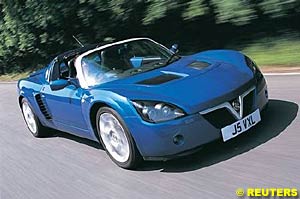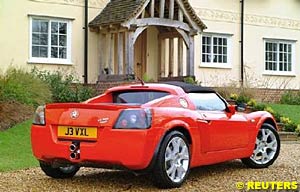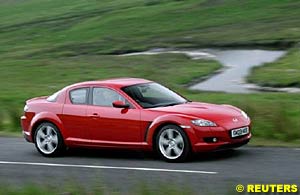

Automotive News and Reviews for the Petrolhead
Reuters Motoring Commentator
In this week's issue:
- Vauxhall's VX220 Turbo Gets in a Spin
- RX-8 Joins Rotary Club
What would you do if you were given the keys to a Vauxhall VX220 Turbo? Explore the limits of its performance and handling, naturally. Whoa, foolish rusher-in: I'm here to tell you that, unless your name happens to be Schumacher, you're in for a roller-coaster ride of sheer, white-knuckled terror.
Handle with Kid Gloves
So the VX220 Turbo is a dangerous car then, is it? Whatever you may have heard, it is nearly always the driver that is dangerous, not the car. But what makes the VX220 Turbo a car you need to handle with kid gloves boils down to just one thing: it's a very, very quick car with an engine in an unusual place - the back.
I have an admission to make: mid-engined cars give me the willies. True, in perfect conditions - for example, a nice wide racetrack with no one else on it - mid-engined cars do deliver the best steering responses and the most in-tune handling balance.
But anywhere else, such as the sort of roads you and I travel every day, I live in perpetual fear that the back end is going to snap mid-corner and catapult me into a spin. That's the thing about rear engines: when the limit is reached, the sting is quick and merciless.
Heroic Feeling
But let's get this into perspective. I feel more confident in the VX220 Turbo than certain other mid-engined machines I could mention. For a start, the VX has grip in spades. In the dry, at least. Kid gloves don't even begin to handle the situation if the road is wet. If the road is bone dry, you can push it incredibly hard before it gives way. When it does, it does so without warning.
Thankfully the steering is both light and hyper-direct - thank most of the weight being over the rear for that - so you can react sufficiently quickly. When you get it right, it is a sublime, heroic feeling. When you get it wrong, the hedge beckons all too readily. The only steering gripe is a slight tendency to wander on the straight-ahead.
So much for how the VX corners. That's only half the story.
The VX220 Turbo has another astonishing element to its arsenal. Pace. The "normal" VX220 has 145bhp and is almost insanely quick. So how do you describe the experience of the Turbo, which has an extra 54bhp to take it up to 197bhp, courtesy of the same 2.0-litre turbocharged engine fitted to the Astra and Zafira GSi?
This car simply catapults forward whenever you apply the accelerator pedal. It gets to 60mph from rest in just 4.7 seconds and will turbo-spin up the rev band in any gear to blitz just about everything else on the road. The power is delivered cleanly and unfussily. Not at all what I was expecting.
Earplugs a Necessity
The engine certainly doesn't appeal to your eardrums though. The four-cylinder power plant sounds gruffly banal, joining tyre noise and tin-can reverberation in a cacophonic symphony, for there is no interior trim to speak of. Refinement? Forget it. Every synapse of your aural system will be frazzled after each trip to buy frozen peas at the supermarket. Never mind the fact that you won't fit anything else in the luggage "compartment".
So how to sum up the VX220 Turbo? It's devilishly quick and, given skill, you will be able to blow away just about everything else on the road. Just make sure you stay on it.
Written by Chris Rees
Maybe Mazda accountants have been on the bottle. The Mazda engineers have come up with the company's best new car for years. But the prices for their new RX-8 coupe are so mouth-wateringly low that you can't help but feel one of the number-crunchers has made a mistake.
Mazda makes no excuses. Indeed, they are so bullish about the RX-8's low cost of ownership, it is putting the sports coupe forward as a serious alternative to the commonplace BMW 3-series coupe company car.
Motor manufacturers normally launch their sporty flagship model at a price few can afford. Demand levels are immaterial, because it is the 'halo effect' that matters. The sports coupe only really exists to make the brand seem more exciting. Not so the RX-8. Mazda actually intends to sell in quite large numbers - 6000 next year in the UK alone.
The four-door, four-seater coupe has four serious competitors in a rapidly expanding sector. Nissan's 350Z sports coupe is almost equally attractively priced and occupies the sportiest end of the spectrum. The pricier but equally new Chrysler Crossfire is the least sporty, while Germany has countered with the BMW Z4 and Audi TT V6.
Rotary Fan
The RX-8 is unique in two key respects. Firstly it is the only four-door coupe and secondly it is the only car sold in Europe with a rotary engine. Rather than trying to explain what a rotary engine is, let's cut to the chase. It is a great engine. Fantastic, in fact.
The engine is available with a choice of two power outputs - 189bhp and 228bhp - and both sing like a skylark on happy pills. In comparison, a V6 sounds like a pigeon scrabbling around for Prozac.
Unusually, the 189bhp car has the more torque - or pulling power, but the differences between the two are more pronounced on paper than behind the wheel. This car uses a five speed gearbox and is capable of accelerating rapidly from anywhere between 2,500 and 7,500 revs - an extraordinarily wide range of useable power. In fact, a huge 80% of torque is on tap from 2,500rpm. It almost doesn't matter what gear you are in.
The 228bhp version is more performance-oriented with power and torque concentrated at the upper rev range and an increased maximum engine speed of 9,000rpm. It also uses a six-speed gearbox to help keep the car in the rev range required to keep the power plant on the boil. The less powerful version is no poverty model, though. Both cars are great fun to drive.
It's probably as well to understand why the rotary engine is so good. In fact, I might as well chuck a history lesson and some tax advice while I'm at it.
Rotary engines got off to a bad start with the radical Ro80 saloon produced by Audi-NSU. They became notorious for their thirst and unreliability. But Mazda has stuck with it and done more to promote the use of rotary engines than any other manufacturer. Indeed, only Lada still makes them. Rotary engines are no longer unreliable and they are not nearly as thirsty as they used to be. Good news for business users whom Mazda want to buy this car. The other advantage is the fact that the engine is classified as a 1.3-litre.
A conventional 1.3-litre piston engine would never be as powerful as this one. But rather than have a piston pumping up and down, a rotary uses a triangular rotor that spins around. The rotor has set teeth cut into it, which mates with a gear to drive the car forward. It's logical, free-spinning and glorious to use.
Handle with Flair
The other benefit of a small engine is the fact it can be squeezed right into the back of the front bonnet, effectively creating a front mid-ship layout. This allows a 50/50 weight distribution over the front and rear axles, which does for the handling what Viagra does for a pensioners' party.
Room Zoom Zoom
The RX-8 is a genuine four-seater, make no mistake about that. You'd be quite happy to stick a client in the back - even one you liked. The 'freestyle' rear doors - the other unique thing about this coupe - are reminiscent of the old 1950's 'suicide doors'. They are half the width of conventional doors and have a hinge at the back so they open backwards.
The equipment list isn't bad either. Standard equipment on both models includes 18 inch alloy wheels, climate control air-conditioning and a BOSE sound system with nine speakers and six CD auto-changer. Safety is attended to with ABS with Electronic Brake Distribution, plus driver, passenger, side and curtain airbags.
The seats are comfortable and very supportive while the cabin is well laid out. There's a real feel-good factor. So basically, I have to admit that I quite like the car. It even looks better than the Audi TT. Dammit. I can't find anything wrong with it. It goes on sale in October. I want one!
Written by Ian Summer
![]() Vauxhall's VX220 Turbo Gets in a Spin
Vauxhall's VX220 Turbo Gets in a Spin
 By way of explanation, let me give you one brief statistic: during Vauxhall's VX220 Turbo launch to dealers and motoring writers earlier this year, no fewer than eleven cars were unceremoniously written off. Yes, eleven people in the space of a week explored the car's limits and fell off the edge.
By way of explanation, let me give you one brief statistic: during Vauxhall's VX220 Turbo launch to dealers and motoring writers earlier this year, no fewer than eleven cars were unceremoniously written off. Yes, eleven people in the space of a week explored the car's limits and fell off the edge.
 Luckily you get more driver aids to help you through any wheel-spinning moments that may occur than you do with the Lotus Elise, on which the VX220 is based. There may not be any traction control, which is a good thing in my book, but you do get ABS. And if it all goes horribly wrong, there's a driver's airbag in the steering wheel - the Lotus doesn't have any airbags.
Luckily you get more driver aids to help you through any wheel-spinning moments that may occur than you do with the Lotus Elise, on which the VX220 is based. There may not be any traction control, which is a good thing in my book, but you do get ABS. And if it all goes horribly wrong, there's a driver's airbag in the steering wheel - the Lotus doesn't have any airbags.
![]() RX-8 Joins Rotary Club
RX-8 Joins Rotary Club
 The company's strategy is as unconventional as its engineering.
The company's strategy is as unconventional as its engineering.
 But the RX-8 is as much a cruiser as an all out sports car, with something of the feel of a tourer about it. It's superbly grippy and well-weighted, but the car is too comfortable and well-equipped to want to risk throwing it round a corner too hard. The suspension set-up is precise yet comfortable on any type of road - appropriate for a car intended to provide a mature step up from the more basic MX-5. That's not to say you don't have fun. It's more that you don't always realise how much fun you're having.
But the RX-8 is as much a cruiser as an all out sports car, with something of the feel of a tourer about it. It's superbly grippy and well-weighted, but the car is too comfortable and well-equipped to want to risk throwing it round a corner too hard. The suspension set-up is precise yet comfortable on any type of road - appropriate for a car intended to provide a mature step up from the more basic MX-5. That's not to say you don't have fun. It's more that you don't always realise how much fun you're having.
© 1995-2005 Kaizar.Com, Inc. . This service is provided under the Atlas F1 terms and conditions.
|
Volume 9, Issue 38
Atlas F1 Exclusive
Ground Rules
Q&A with Paul Stoddart
View from the Paddock
2003 Italian GP Review
2003 Italian GP Review
Three Years Later
Stats Center
Qualifying Differentials
SuperStats
Charts Centre
Columns
On the Road
Elsewhere in Racing
The Weekly Grapevine
> Homepage |